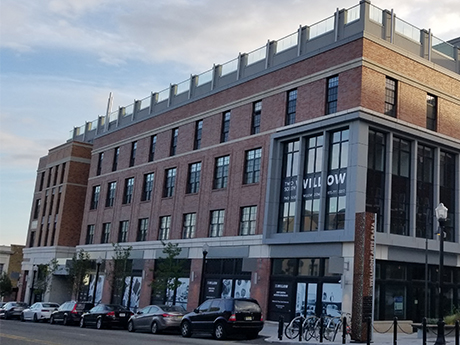By Brian Katz (CEO), Amy Staats (vice president), Jonathan Greenberg (director), Adam Caplan (director) and Hugh Scullin (vice president) of Katz & Associates
The Northern New Jersey retail real estate market has been flourishing in the post-COVID-19 era. Inventory continues to shrink across the board, with exceptional demand for drive-thru locations and mid-size boxes. Furthermore, the modern, well-anchored neighborhood and power centers seldom have more than one or two small shop vacancies.

Brian Katz, Katz & Associates
Some categories in high demand include discount apparel, grocery, food, health and beauty, fitness and medical. Northern New Jersey specifically benefits from its critical mass and its ease of access to main roads and points of entry. Tenants that have been able to refocus and adapt have thrived in a market that already has a lot going for it.
Simply put, the post-COVID bounce has been better than we could have imagined, and from a company standpoint, the pipeline of deals that are in the works or have closed has been among the strongest in our history.
Leasing Activity
Leasing activity is up. Market adjustments aside, leasing activity has pretty much returned to pre-pandemic levels. In some instances, it’s even easier to get deals across the finish line since tenants and landlords have had time to fine tune their “non-negotiables” and cut through a lot of red tape that often clogged the pipeline and slowed the process.

Amy Staats, Katz & Associates
As pertains to landlords, there is still a learning curve for some of the mom-and-pop operators who were hoping that the pandemic would offer reduced rents and landlords assisting with their buildout expenses. In reality, the rents are equal to or in some cases greater than pre-pandemic rents, and landlords are less likely to contribute to tenants’ buildouts. However, some landlords are willing to get creative with tenant improvement (TI) allowances in order to get deals over the finish line.
In addition, newly constructed, mixed-use properties in secondary or tertiary retail corridors across the region — particularly those without ample onsite parking — have been a bit more challenging to lease. There are fewer retailers willing to roll the dice on these properties at the rent levels owners are asking.
User Profiles
Grocery, discount apparel and home improvement are dominating the big and junior box spaces. In the smaller shop space, we have seen an increase in the fitness, health, medical and wellness concepts including dental, physical therapy, dermatology, urgent care centers, cryotherapy and IV drip therapy. Fast food restaurants have also been making strong expansionary pushes.

Jonathan Greenberg, Katz & Associates
The market for automotive uses and daycares is also very strong right now. And with New Jersey legalizing recreational cannabis, brokers are fielding dozens of calls from prospective users looking to open a dispensary. Fast food restaurants, urgent care centers, and cannabis retailers are willing to pay at- or above-market rents for optimal sites within a trade area. On the flip side, there are fewer apparel retailers actively seeking urban, street-front spaces than pre-COVID.
Industry Morale
Overall, the mood among landlords and retail tenants is on the upswing now that it appears the worst of the COVID era is behind us.
With relatively few new shopping center developments opening across the region since the start of the pandemic and positive net absorption for several consecutive quarters, landlords are willing to wait a bit longer for the right tenant and deal structure.
Most tenants are upbeat, though supply chain, labor and inflation issues still linger and are influencing their proposed deal terms. It takes both sides to want to make a deal. Both sides of the equation are eager to transact but have less patience for protracted negotiations. It seems that deals are either getting done at a quicker pace or not getting done at all.
Creativity is necessary in today’s times, and both sides seem to be relatively open to what the other has to offer. But success only comes when both sides can come to terms. Negotiations must be fair and equitable for both parties, and the increase in building costs has and will continue to make this more difficult as time goes on.
Key Tenant and Landlord Wants
We are seeing tenants focus on base rent, as well as packages for improvements, other allowances and overall flexibility. Landlords are looking for long-term commitments accompanied by guarantees.

Adam Caplan, Katz & Associates
Regional and local landlords are hesitant to provide generous TI packages to tenants with less-than-stellar financials or insist on early lease terminations if they don’t hit their sales projections. Large REITs continue to try to “buy up” rents in exchange for larger improvement packages.
Consumption of Retail
With the last of the Sears and Kmart stores closing their doors in the state, other retailers across the region have taken note of missteps and have clearly taken drastic action to improve their own experiences.
For example, the glass-filled facades and sun-drenched prototypical stores of discount grocer Lidl have proven popular amongst middle-market grocery shoppers and can improve the aesthetics of centers and retail corridors alike. Quick-service restaurants’ improvement of drive-thru lane lengths and configurations are shortening times between ordering and pick up.
Consumers in Northern New Jersey expect excellence across a given retail tenant mix, whether it’s the diverse, interesting independent retailers and restaurants lining Washington Street in Hoboken or the reliable big-box stores that have lined Route 22 in Union/Springfield for decades. Factors from ease of parking to how the center looks and shops are good indicators of the quality of the operator.
The retail experience is important. Shopping centers that have potholes throughout the parking lot or garbage overflowing in their receptacles or that just generally have an outdated feel have these issues articulated in letter of intent negotiations. If the landlord wants a market rent, the maintenance of the shopping center needs to help support it.
Development Activity
We continue to see new development and construction, but it is fair to say that much of what is under development has been in the pipeline for several years.

Hugh Scullin, Katz & Associates
Rising costs of construction, coupled with supply chain issues, are very much a part of the equation when negotiating deals today. Construction costs have skyrocketed, and the quantity of labor demanded is far outpacing the supply of labor, making it tough to complete projects in a reasonable period of time.
When considered in conjunction with the backlog of projects, it seems clear that the market will be out of equilibrium in terms of bringing new projects on line. However, there is still a tremendous amount of mixed-use development in opportunity zones, particularly in parts of Jersey City, Hoboken, Hackensack and Newark. There aren’t many new open-air shopping center developments in the pipeline across the region, though several older centers along the Route 440 corridor in Jersey City and Routes 4 and 17 in Paramus will be undergoing significant redevelopments in the next year or two.
Future Predictions
While there is uncertainty, the dramatic drop in retail bankruptcies among national retailers and restaurants over the past two years, as well as the dramatic influx of residents in Bergen, Essex and Hudson counties, may buoy retail real estate in Northern New Jersey. To this end, we expect deals to continue to get done despite some of the economic headwinds we may face in the coming months.
Rate hikes are going to play a major role in how consumers respond to the market, and impending global shortages are going to impact purchases and how people allocate their dollars. Hopefully the economy can withstand the rising costs of everything from food to construction and still allow for retailers and restaurants to expand.
The good news is that there are always retail categories that do well in economic downturns, and brokers with foresight can take advantage of what the market is yielding. For example, the retail cannabis sector is one that will grow now that the widespread store openings across the state are in full force.
By staying informed, working smartly, maintaining relationships and remaining at the forefront of trends and opportunities, brokers can create value for clients and themselves, even in turbulent economic times


